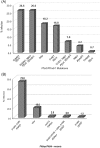Prevalence of mutations linked to antimalarial resistance in Plasmodium falciparum from Chhattisgarh, Central India: A malaria elimination point of view
- PMID: 29192183
- PMCID: PMC5709362
- DOI: 10.1038/s41598-017-16866-5
Prevalence of mutations linked to antimalarial resistance in Plasmodium falciparum from Chhattisgarh, Central India: A malaria elimination point of view
Abstract
Antimalarial drug resistance is a major global challenge in malaria control and elimination. Mutations in six different genes of Plasmodium falciparum (crt, mdr1, dhfr, dhps, ATPase6 and K-13 propeller) that confer resistance to chloroquine, sulphadoxine-pyrimethamine and artemisinin-based combination therapy were analyzed in samples from Chhattisgarh. Seventy-eight percent of the samples were found to have a pfcrt mutation (53% double, 24% triple and 1% single mutant), and 59% of pfmdr1 genes were found to have an N86Y mutation. Double mutations were recorded in pfdhfr gene among 76% of the samples while only 6% of the samples harbored mutant genotypes in pfdhps. No mutation was found in the K-13 propeller gene, while only one sample showed a mutant genotype for the PfATPase6 gene. The Tajima test confirmed that there is no role of evolutionary natural selection in drug resistance, and gene pairwise linkage of disequilibrium showed significant intragenic association. The high level of pfcrt mutations suggests that parasite resistance to chloroquine is almost at a fixed level, whereas resistance to SP is evolving in the population and parasites remain sensitive to artemisinin derivatives. These findings provide potential information and understanding of the evolution and spread of different drug resistance alleles in Chhattisgarh.
Conflict of interest statement
The authors declare that they have no competing interests.
Figures



References
-
- World Malaria Report 2016. World Health Organization, Geneva. http://www.who.int/malaria/publications/world-malaria-report-2016/report... (2016).
-
- Malaria situation in India. NVDCP. http://www.nvbdcp.gov.in/Doc/malaria-situation-Feb17.pdf.
-
- Bharti PK, et al. Therapeutic efficacy of chloroquine and sequence variation in pfcrt gene among patients with falciparum malaria in central India. Trop Med Int Health. 2010;15:33–40. - PubMed
Publication types
MeSH terms
Substances
LinkOut - more resources
Full Text Sources
Other Literature Sources
Research Materials

